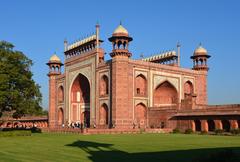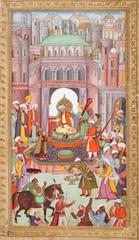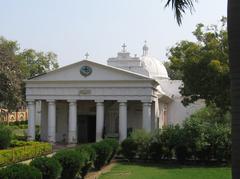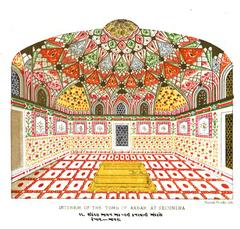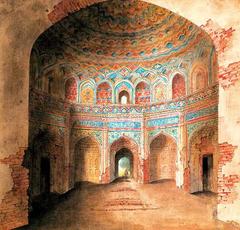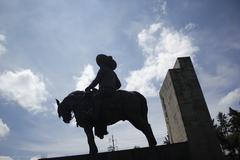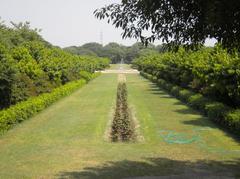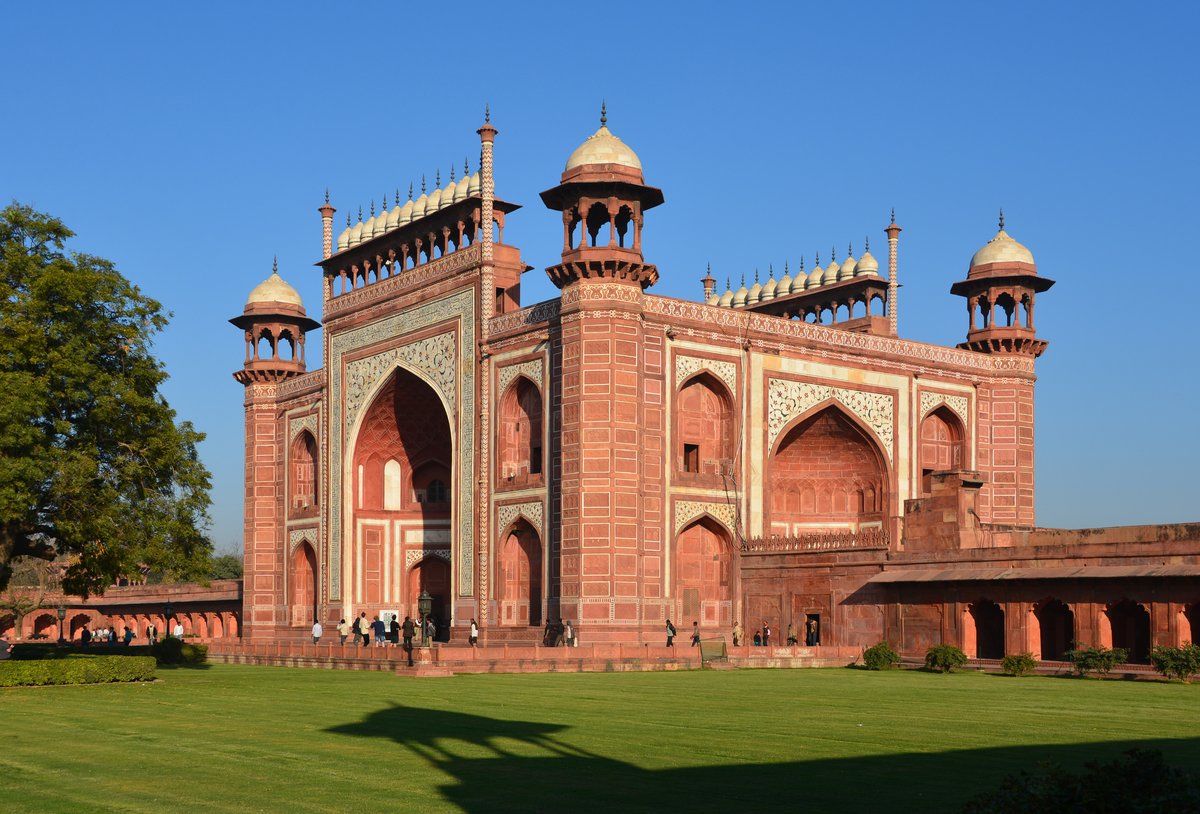
Darwaza-i-Rauza Visiting Hours, Tickets, and Agra Historical Sites Guide
Date: 14/06/2025
Introduction
Darwaza-i-Rauza, or the “Great Gate,” stands as the majestic and ceremonial entrance to the Taj Mahal complex in Agra, India. Constructed during the reign of Mughal Emperor Shah Jahan between 1632 and 1648 CE, this gateway is not simply an architectural marvel but also a symbolic threshold—ushering visitors from the bustling world outside into the serene paradise of the Taj Mahal gardens. Crafted from red sandstone and adorned with marble inlays and Quranic calligraphy, Darwaza-i-Rauza embodies the artistic and spiritual vision of the Mughal era.
This comprehensive guide will provide historical background, architectural insights, practical visitor information—such as visiting hours, ticketing details, accessibility, and travel tips—and highlight the significance of Darwaza-i-Rauza within the broader context of Agra’s Mughal heritage. For further information, refer to authoritative sources such as the Archaeological Survey of India, expert travel guides, and the resources listed at the end of this article (madainproject.com), (theindosphere.com), (Albom Adventures).
Contents
- Introduction
- Historical Origins and Construction
- Architectural Features and Symbolism
- Visitor Information: Hours, Tickets & Accessibility
- Travel Tips and Nearby Attractions
- Cultural and Spiritual Significance
- Preservation and Visitor Experience
- Frequently Asked Questions (FAQ)
- Conclusion and Visitor Summary
- Sources and Further Reading
Historical Origins and Construction
The Darwaza-i-Rauza was built as the principal gateway to the Taj Mahal, which Emperor Shah Jahan commissioned as a mausoleum for his wife, Mumtaz Mahal (madainproject.com). Constructed between 1632 and 1648 CE, it was an integral part of the Taj Mahal complex—completed in 1653 CE at an estimated cost equivalent to billions in today’s currency.
The gate was designed to symbolize the transition from the ordinary world to the spiritual realm, echoing the Mughal emphasis on ceremonial entrances and architectural symbolism (theindosphere.com). Its alignment and grandeur reflect imperial ambitions and religious ideals.
Architectural Features and Symbolism
Structural Design
- Built from red sandstone, the Darwaza-i-Rauza rises nearly 30 meters, dominating the northern entrance forecourt.
- The main central arch perfectly frames the first view of the Taj Mahal, flanked by smaller arches and marble lattice screens (jali), which interplay with the sunlight to create a spiritual ambiance (theindosphere.com).
- The facade is adorned with:
- A large central iwan (arched doorway)
- Symmetrical flanking arches
- Pietra dura inlay with floral and geometric motifs (companion-travels.com)
- Eleven chhatris (domed pavilions) along the parapet, known as guldastas, and octagonal turrets, which give the gate a fortress-like appearance (appealingindia.com).
Calligraphy and Inscriptions
- Quranic verses, especially Surah Al-Fajr (89:27-30), are rendered in black marble inlay in elegant Thuluth script. They welcome visitors and reinforce the spiritual significance of the site (theindosphere.com), (Infinite Walks).
- The calligraphy is designed with an optical illusion, growing in size higher up so the script appears uniform from ground level (aspirantsessay.com).
Symbolic and Spiritual Role
- The gateway is not only a physical entry but a metaphysical passage from the earthly world into the paradise symbolized by the Charbagh gardens and the Taj Mahal mausoleum.
- It encourages visitors to pause and reflect, serving as a spiritual threshold that prepares one for the grandeur beyond (madainproject.com), (LinkedIn).
Visitor Information: Hours, Tickets & Accessibility
Visiting Hours
- Open daily from sunrise to sunset, approximately 6:00 AM to 6:30 or 7:00 PM.
- Closed on Fridays for general visitors (open only for prayers at the mosque).
Ticket Information
- Entry to the Taj Mahal complex (including Darwaza-i-Rauza) requires a ticket:
- Indian citizens: ₹45
- Foreign tourists: ₹1,050
- SAARC/BIMSTEC nationals: ₹540
- Children under 15: Free
- Purchase tickets online via the ASI website or at ticket counters near the entrance.
- Group bookings are available, with identification required for verification (Albom Adventures).
Accessibility
- The complex is accessible with ramps, pathways, and wheelchair rentals available at the entrance.
- Facilities include restrooms, drinking water, seating, and cloakrooms (Albom Adventures).
Security and Entry Procedures
- Expect strict security checks; large bags, food, tobacco, tripods, and drones are prohibited.
- Only small bags, cameras, water bottles, and mobile phones are permitted (Albom Adventures).
Travel Tips and Nearby Attractions
- Best Time to Visit: Early morning for tranquil atmosphere and ideal photography conditions, or late afternoon for warm lighting. Winter months (Nov-Feb) offer cool weather.
- Crowd Avoidance: Weekends and major holidays can be crowded; weekdays and opening hours are quieter (Medium).
- Photography: The central arch frames the Taj Mahal beautifully. Tripods are not allowed.
- Dress Code: Modest attire is required, covering shoulders and knees; shoes must be removed or covered in the mausoleum.
- Nearby Attractions: Agra Fort, Fatehpur Sikri (with Buland Darwaza), Mehtab Bagh, and Itimad-ud-Daulah’s Tomb.
Cultural and Spiritual Significance
- Darwaza-i-Rauza exemplifies Mughal cultural synthesis, blending Persian, Turkish, and Indian elements (Culture and Heritage).
- The gate’s calligraphic and floral decorations, coupled with its ceremonial function, reinforce the Mughal ideals of paradise and spiritual journey (Infinite Walks).
- It has influenced later Mughal and Indo-Islamic architecture across the subcontinent (appealingindia.com).
Preservation and Visitor Experience
- The Archaeological Survey of India maintains the site, focusing on structural integrity and the preservation of artistic details.
- Darwaza-i-Rauza’s role as a communal threshold continues, welcoming millions of visitors and serving as a focal point for cultural exchange (madainproject.com).
- Ongoing conservation efforts ensure that the spiritual atmosphere and architectural grandeur are preserved for future generations (aspirantsessay.com).
Frequently Asked Questions (FAQ)
Q: What are the visiting hours for Darwaza-i-Rauza?
A: Open daily from sunrise to sunset, generally 6:00 AM to 6:30 or 7:00 PM. Closed on Fridays except for mosque worshippers.
Q: Do I need a separate ticket for Darwaza-i-Rauza?
A: No, entry is included with the Taj Mahal complex ticket.
Q: Is Darwaza-i-Rauza accessible for visitors with disabilities?
A: Yes, ramps, pathways, and wheelchairs are available.
Q: Can I take photos at Darwaza-i-Rauza?
A: Yes, photography is allowed, but tripods are not permitted inside.
Q: Are guided tours available?
A: Yes, official guides and audio tours are available at the entrance (Albom Adventures).
Conclusion and Visitor Summary
Darwaza-i-Rauza stands as both a stunning architectural achievement and a profound spiritual gateway to the Taj Mahal. By planning your visit with knowledge of the gate’s history, symbolism, visiting hours, ticketing procedures, and accessibility, you can ensure a meaningful and memorable experience. Early mornings and late afternoons are best for tranquil visits and striking photographs.
Beyond the gate, Agra boasts a wealth of historical sites—making Darwaza-i-Rauza the perfect starting point for exploring Mughal heritage. Preservation efforts by the Archaeological Survey of India and UNESCO underscore its value as a cultural treasure for generations to come.
To enrich your visit, consider guided tours and stay updated with the latest travel information. Download the Audiala app for personalized guides and explore our related articles for additional insights.
Visuals and Media
Images to include:
- High-resolution image of Darwaza-i-Rauza with alt text: “Darwaza-i-Rauza entrance gate at Taj Mahal complex, Agra.”
- Photo of the Taj Mahal framed by Darwaza-i-Rauza’s central arch.
- Map of the Taj Mahal complex highlighting Darwaza-i-Rauza and nearby attractions.
Sources and Further Reading
- Darwaza-i-Rauza: Visiting Hours, Tickets, and Historical Significance of Agra’s Great Gate, 2024, Madain Project (madainproject.com)
- The Indosphere: The Taj Mahal - Symbol of Love (1632), 2024 (theindosphere.com)
- Companion Travels: Taj Mahal Historical Importance and Architecture, 2024 (companion-travels.com)
- Appealing India: World Heritage Places - Taj Mahal, 2024 (appealingindia.com)
- Aspirants Essay: Paragraph on Taj Mahal, 2024 (aspirantsessay.com)
- Ease India Trip: Taj Mahal Entry Guide, Gates Layout, Access, 2024 (easeindiatrip.com)
- Albom Adventures: Visit Taj Mahal Guide, 2025 (Albom Adventures)
- Infinite Walks: Things to Know Taj Mahal, 2024 (Infinite Walks)
- Culture and Heritage: Exploring the Magnificent Architecture of Fatehpur Sikri and Buland Darwaza near Agra, 2024 (Culture and Heritage)
